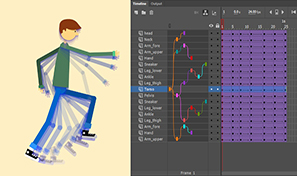
Adobe animate tutorial for beginners movie#
Right-click on the ball and select Convert to Symbol. Name it “ball” and set its type to Movie Clipand its registration to the center anchor point.Ĭurrently, both the ball and ground layers only have 1 frame. In order to use tweens on this object, it needs to be a symbol.


Let’s first define the ground our ball is going to hit: Save and name your document by going to File > Save As… Launch Adobe Animate and create a new document with the following settings: Now that we have a clear goal in mind, let’s translate this sketch into an animation with Adobe Animate. For this first exercise, we’ll work on creating a convincing rubber ball one might find at a playground. The weight and material of the ball should be taken into account. Don’t forget that the volume (how much water it could hypothetically hold) should remain the same, no matter how distorted the ball is. Squash & stretch: The ball elongates as it falls, flattens when it hits the ground and returns to its normal shape in the slower parts of the arc.Spacing: How close/far apart is one frame from the previous and next one? Frames should overlap when at slow sections of the arc, and be spaced further apart when the motion accelerates.Timing: Where and how many times does the ball hit the ground?.We’ll also apply the “squash & stretch” principle:

The first step is to sketch the “timing” and “spacing” you want your ball to take.
Adobe animate tutorial for beginners download#
You can watch the finished example below and download the. It’s a great way of demonstrating the “squash and stretch” principle, but it also addresses “exaggeration”, “arcs” and “timing”. The “bouncing ball” exercise has been used to teach the basic principles of animations for decades – wether it be traditional 2D animation, stop motion or 3D animation.


 0 kommentar(er)
0 kommentar(er)
